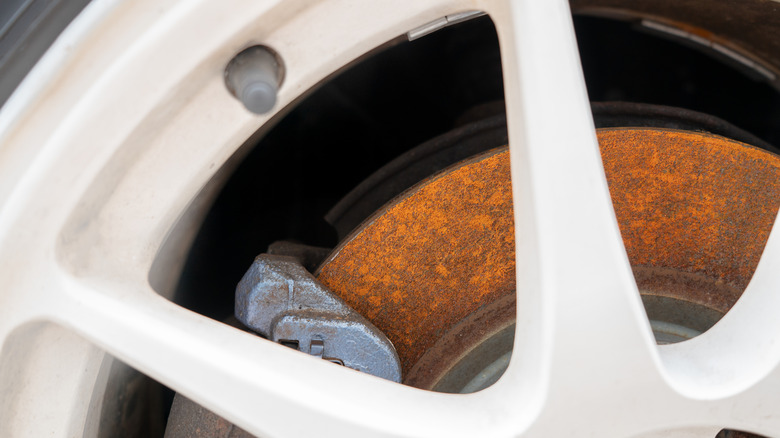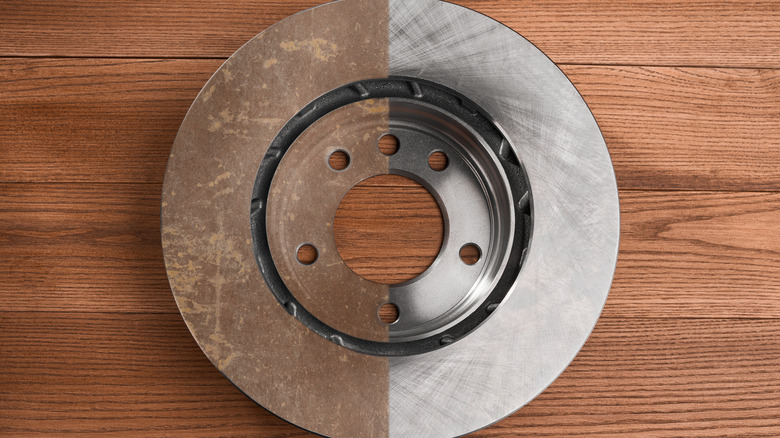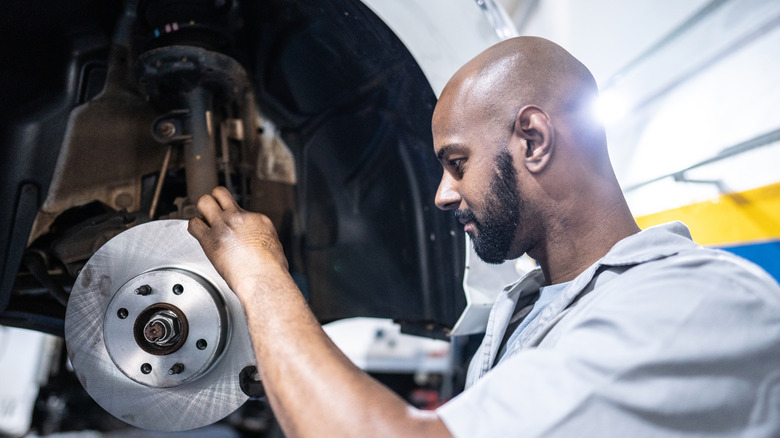Want To Clean Your Brake Rotors At Home? Here's How To Do It
Brake rotors are nothing new — the technology was popularized in motorsport throughout the early 1950s, on models such as the Le Mans-winning Jaguar C-Type, before being introduced to mainstream models like the innovative Citroen DS a few years later. Despite decades passing, very little has changed in the way brake rotors work, although high-performance cars do sport fancy carbon rotors with ceramic pads, as the combination provides superior stopping capabilities.
However, for those of us who aren't fortunate enough to get behind the wheel of a trick supercar each morning, the chances are we all have fairly typical cast-iron brake rotors taking care of stopping behind our alloys. Cast-iron is ideal for brake rotors, as it's hard-wearing, cheap to produce, and relatively long-lasting too. One downside, though, is that cast iron brake rotors can look fairly unsightly at times, as cast iron is easily susceptible to rusting.
This is especially true on cars which are used sparingly, while cars used more frequently will generally avoid surface corrosion on the rotor's face, as regular braking cleans the surface. Also, brake dust from pads can cling to areas of the rotor, and is typically stubborn to remove, further adding to the rotor's unsightly appearance. All is not lost, though, as cleaning your brake rotors at home is a simple DIY task that all motorists should feel comfortable undertaking, and all you'll need is some soapy water, brake cleaner, a rag or cloth, and a wire brush for particularly stubborn stains.
Cleaning your brake rotors at home couldn't be easier
While it is possible to clean your brake rotors at home without removing the wheel, caliper, or brake rotor, doing so will allow you to get better access, and therefore achieve a better result. If you have access to some basic automotive tools, it's best to jack the car up, secure it with an axel stand, and then remove the wheel. Doing so will allow you to access and remove both the caliper and then brake rotor — if you're unsure about how to approach this, don't worry, there are many helpful brake-removal and replacement guides online to walk you through the process.
With the brake rotor removed, you can now begin to clean it up. To begin with, use warm soapy water to clean it just as you would the dishes. Agitating the surface with a sponge as you go will help dislodge the majority of rust and brake dust staining. Once finished, simply dry the rotor with a cloth and check out your results. If stubborn stains remain, consider soaking the rotor in brake cleaner, and then agitating them with a wire brush. This more aggressive approach should then dislodge those harder to clear stains.
Preventing dirty brake rotors down the road
Cleaning your brake rotors is just as easy as changing your oil at home, if not easier, but keeping them clean is another matter. Regardless of how well you shine them up, cast-iron brake rotors will continue to rust when exposed to the elements, and brake dust will continue to cling to the rotor as you drive along. There is sadly nothing you can do in regard to keeping your rotors looking immaculate, although there is one approach you can take which will help them from deteriorating too quickly.
Thankfully, the remedy for ongoing brake rotor cars is easy — just drive your car. As you brake, the pads will clean surface corrosion and brake dust from the face of the rotor. It's when the car is stationary that surface corrosion builds up, and that brake dust embeds into the rotor's surface and becomes stubborn, so regular driving will help to keep unsightly rotors at bay.


